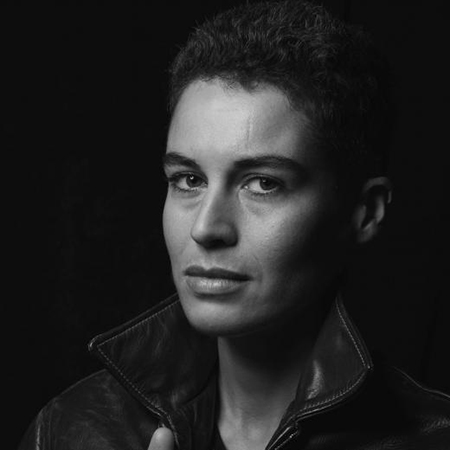I wonder if Iris is going to send me a postcard or if it is too late since they are coming back tomorrow. This week Paris is empty. You are not here either, but it makes no difference. I don’t know you yet. You have no relation to my loneliness, it is not for you I am growing all these plants. I wait for Iris to come back from holiday. I don’t receive a postcard and to pass the time I steal cuttings from garden centres, discreetly slipping all kinds of stems into my sleeves. I offer them this warm place against my skin after brutally ripping them. I feel them snuggling up against my arms on my way home. I walk slowly, avoiding harsh movements. I owe them that. At the apartment, I put them in water and watch their roots grow. Then I will have to repot them, and I won’t see the roots anymore. It will be sad, the roots are my favourite part.
There must be transparent plant pots made especially to observe them, but even then the soil remains opaque. Roots are shy and prefer darkness. Once they are in the ground, I respect their privacy and stop watching their growth.
Iris will probably come see me tomorrow. I wish the leaves would grow quicker to impress them when they get back. I check their size multiple times every hour. I know it’s obsessive, and by doing this I don’t see them changing. If I looked only once a week, maybe I would notice a difference.
I believe plants also watch us. I know one, Boquila trifoliata, to use its Latin name, a climbing plant whose leaves change shape depending on the type of plant it’s climbing on. It mimics them. To hide, to fit in, to find a family, no one knows. It can mimic the plant closest to it without touching it. One stem could have leaves of different shapes from mirroring all the species it found on its path.
What I wonder is: how does it distinguish the shape of the leaves? According to the theories I have read, it is able to pick up airborne organic compounds, since we know that plants are capable of volatile communication.
But this is probably a mainstream botanist theory. I believe the signals mix in the wind. Anyone would be lost, but Boquila really is able to detect which plant is the closest. The experiment was even conducted with plastic plants, and it still worked. It was able to mimic the shape of the plastic. That is all I need to be convinced: plants can see.
Iris never agrees with me, Iris will say it doesn’t make any sense, but to me it is evident. How could someone think plants are blind when they are so sensitive to light? I know they don’t have eyes, but they are made entirely to detect any variation in light. Isn’t that the point of seeing? No need for an eye when your entire organism is one. They might be capable of seeing colours we can’t, like ultraviolets, and probably even beyond that. We have no idea how they see, but their entire beings are likely only vision. Too often we underestimate plants on account of their limited ability for movement.
We shouldn’t. In the absence of mobility, plants have to develop a hypersensitivity to the few things it can sense – in this instance, light. Of course, they can see anything so differently, in ways we could not fathom. Animals can be blind, plants cannot. We must accept that the leaves are eyes, the stems are eyes, the entire plant is an eye, an eye-organism feeding off of what it sees. It’s evident.
I am afraid of the end of the world and the extinction of plants. Maybe if we could prove they have eyes we would respect them more. Eyes are sacred, right?
While Iris is away, while Iris doesn’t send me a postcard, I surround myself with motionless eyes watching over me, filling my solitude.
I am not trying to recreate the garden of Eden. There are too many problems in the Bible. I don’t believe that this nature has ever existed, but we must save it still. Save our fantasies and our utopias from the hopelessness tightening more and more around us each day. I believe in shapeshifting more because leaves can change shape. When Adam and Eve were banished from Paradise, it is said that their eyes were opened. That’s how it’s written, several times. From the beginning, all our problems have been eye problems. It was supposedly the moment they discovered that they were naked. Before then, their vision was probably the same as plants’ and ever since, humans have forgotten that plants are sacred eyes.
Iris is coming back tomorrow. We will go out, meet L, meet Mimo and Daph and build all sorts of heavens. We will do what we can. I hope we remain hopeful. I hope Iris likes my new plants and my theory of eye-organisms. There is you, too. I am not waiting for you. I am not waiting for anything in particular, but you shudder in a crawlspace within me. My memories of you will always precede your arrival, but nothing foretells you.
Originally published in French by Cambourakis editions

Camille Cornu grew up in Normandy and studied literature and creative writing at Paris 8 University. They lived in Glasgow for several years where they developed their own writing in the English language and began translating for journals from English to French and gained an understanding of the contrast in trans identities between the UK and France. They are a part of queer literary collective RER Q which focuses on poetry and the defence of gender minorities and performs in Europe. Photosyntheses is their second full-length novel.

Sam Nartus-Fois is an emerging French to English translator and writer of queer literature. Originally from France but now based in the UK, they have a Master’s degree in literary translation from the University of Essex and is currently pursuing a PhD program in linguistics researching grammatical gender. He has translated fiction, non-fiction, poetry, and theatre, and their work focuses both on literary and academic texts surrounding the issues of transness and queerness as well as feminism. His translation One must fall from a comet to understand solitude was published by Sybil Journal.